High-Speed Kinetic Energy Storage System Development and ANSYS Analysis of Hybrid Multi-Layered Rotor Structure
Abstract
1. Introduction
2. Design Parameters of Flywheel Energy Storage System
2.1. Energy and Power Parameters
- is the angular velocity;
- ro is the outer radius;
- ri is the inner radius (0 for a solid disc);
- ν is Poisson’s ratio;
- is the material density;
- σt, max is the yield stress.
2.2. Structural Parameters and Material Selection
2.2.1. Mild Steel
- ▪
- Suitable yield point and tensile strength for many applications;
- ▪
- Suitable impact resistance;
- ▪
- Resistance to brittle fractures;
- ▪
- Good weldability;
- ▪
- Good formability;
- ▪
- Good machinability.
2.2.2. Titanium Alloy
2.2.3. Carbon Composite Material
- ▪
- Low density;
- ▪
- Lightweight;
- ▪
- Corrosion resistance;
- ▪
- Easy production method;
- ▪
- Low coefficient of friction;
- ▪
- Can be considered high strength.
- ▪
- Aviation sector;
- ▪
- Spacecraft;
- ▪
- Automotive;
- ▪
- Maritime;
- ▪
- Industrial equipment.
2.3. Rotor Design and Specifications for Simulation
2.4. Performing Program Settings for Simulations
2.5. Analysis Findings and Interpretation
3. ANSYS Analyses Results
3.1. Solid Rotor Simulation Results
3.1.1. 3 mm Layered Hybrid Rotor Simulation Results
3.1.2. 5 mm Layered Hybrid Rotor Simulation Results
3.1.3. 10 mm Layered Hybrid Rotor Simulation Results
3.1.4. 20 mm Layered Hybrid Rotor Simulation Results
3.2. Analytical Calculations for the Solid Rotor
4. Discussion
Comparative Analysis of Systems
5. Conclusions
Author Contributions
Funding
Institutional Review Board Statement
Informed Consent Statement
Data Availability Statement
Conflicts of Interest
References
- Choudhury, S. Flywheel energy storage systems: A critical review on technologies, applications, and future prospects. Int. Trans. Electr. Energy Syst. 2021, 31, e13024. [Google Scholar] [CrossRef]
- Amiryar, M.E.; Pullen, K.R. A review of flywheel energy storage system technologies and their applications. Appl. Sci. 2017, 7, 286. [Google Scholar] [CrossRef]
- Hedlund, M.; Lundin, J.; De Santiago, J.; Abrahamsson, J.; Bernhoff, H. Flywheel energy storage for automotive applications. Energies 2015, 8, 10636–10663. [Google Scholar] [CrossRef]
- Erhan, K. Investigation of Flywheel and Ultracapacitor Technologies Used in Electric and Hybrid Electric Vehicles and Prototype Production of Flywheel Energy Storage Unit; Kocaeli University: İzmit, Turkey, 2018. [Google Scholar]
- Ayaz, M.; Icer, Y.; Karabinaoglu, M.S.; Erhan, K. Energy management algorithm development for smart car parks including charging stations, storage, and renewable energy sources. Comput. Electr. Eng. 2024, 119, 109478. [Google Scholar] [CrossRef]
- Akram, U.; Nadarajah, M.; Shah, R.; Milano, F. A review on rapid responsive energy storage technologies for frequency regulation in modern power systems. Renew. Sustain. Energy Rev. 2020, 120, 109626. [Google Scholar] [CrossRef]
- Sebastián, R.; Alzola, R.P. Flywheel energy storage systems: Review and simulation for an isolated wind power system. Renew. Sustain. Energy Rev. 2012, 16, 6803–6813. [Google Scholar] [CrossRef]
- Karrari, S.; Noe, M.; Geisbuesch, J. High-speed flywheel energy storage system (FESS) for voltage and frequency support in low voltage distribution networks. In Proceedings of the 2018 IEEE 3rd International Conference on Intelligent Energy and Power Systems (IEPS), Kharkiv, Ukraine, 10–14 September 2018; pp. 176–182. [Google Scholar]
- Available online: https://interestingengineering.com/energy/china-world-largest-flywheel-energy-storage (accessed on 20 December 2024).
- Erhan, K.; Özdemir, E. Prototype production and comparative analysis of high-speed flywheel energy storage systems during regenerative braking in hybrid and electric vehicles. J. Energy Storage 2021, 43, 103237. [Google Scholar] [CrossRef]
- Li, X.; Palazzolo, A. A review of flywheel energy storage systems: State of the art and opportunities. J. Energy Storage 2022, 46, 103576. [Google Scholar] [CrossRef]
- Kim, S.J.; Hayat, K.; Nasir, S.U.; Ha, S.K. Design and fabrication of hybrid composite hubs for a multi-rim flywheel energy storage system. Compos. Struct. 2014, 107, 19–29. [Google Scholar] [CrossRef]
- Rastegarzadeh, S.; Mahzoon, M.; Mohammadi, H. A novel modular designing for multi-ring flywheel rotor to optimize energy consumption in light metro trains. Energy 2020, 206, 118092. [Google Scholar] [CrossRef]
- Li, X.; Mittelstedt, C.; Binder, A. A review of critical issues in the design of lightweight flywheel rotors with composite materials. E I Elektrotechnik Informationstechnik 2022, 139, 204–221. [Google Scholar] [CrossRef]
- Ha, S.K.; Kim, D.J.; Sung, T.H. Optimum design of multi-ring composite flywheel rotor using a modified generalized plane strain assumption. Int. J. Mech. Sci. 2001, 43, 993–1007. [Google Scholar]
- Wen, S.; Jiang, S. Optimum design of hybrid composite multi-ring flywheel rotor based on displacement method. Compos. Sci. Technol. 2012, 72, 982–988. [Google Scholar] [CrossRef]
- Hu, D.; Dai, X.; Li, W.; Zhu, Y.; Zhang, X.; Chen, H.; Zhang, Z. A review of flywheel energy storage rotor materials and structures. J. Energy Storage 2023, 74, 109076. [Google Scholar]
- Chen, H.; Cong, T.N.; Yang, W.; Tan, C.; Li, Y.; Ding, Y. Progress in electrical energy storage system: A critical review. Prog. Nat. Sci. 2009, 19, 291–312. [Google Scholar] [CrossRef]
- Arslan, M.A. Flywheel geometry design for improved energy storage using finite element analysis. Mater. Des. 2008, 29, 514–518. [Google Scholar] [CrossRef]
- Molina, M.G. Dynamic modelling and control design of advanced energy storage for power system applications. Dyn. Model. 2010, 300, 49–92. [Google Scholar]
- Brockbank, C.; Greenwood, C. Fuel economy benefits of a flywheel & CVT based mechanical hybrid for city bus and commercial vehicle applications. SAE Int. J. Commer. Veh. 2009, 2, 115–122. [Google Scholar]
- Wang, P.; Gu, T.; Sun, B.; Liu, R.; Zhang, T.; Yang, J. Design and Performance Analysis of Super Highspeed Flywheel Rotor for Electric Vehicle. World Electr. Veh. J. 2022, 13, 147. [Google Scholar] [CrossRef]
- Cross, D.; Brockbank, C. Mechanical Hybrid System Comprising a Flywheel and CVT for Motorsport and Mainstream Automotive Applications; SAE Technical Paper; SAE: Warrendale, PA, USA, 2009. [Google Scholar] [CrossRef]
- Akhil, A.A.; Huff, G.; Currier, A.B.; Kaun, B.C.; Rastler, D.M.; Chen, S.B.; Gauntlett, W.D. DOE/EPRI 2013 Electricity Storage Handbook in Collaboration with NRECA; Sandia National Laboratories: Albuquerque, NM, USA, 2013; Volume 1, p. 340. [Google Scholar]
- Ragheb, M.; Tung, M.T. Kinetic Energy Flywheel Energy Storage; University of Illinois at Urbana Champaign: Champaign, IL, USA, 2013. [Google Scholar]
- Kamf, T. High Speed Flywheel Design: Using Advanced Composite Materials. Master’s Thesis, Uppsala University, Uppsala, Sweden, 2012. [Google Scholar]
- Genta, G. Kinetic Energy Storage: Theory and Practice of Advanced Flywheel Systems; Butterworth-Heinemann: Oxford, UK, 2014. [Google Scholar]
- Conteh, M.A.; Nsofor, E.C. Composite flywheel material design for high-speed energy storage. J. Appl. Res. Technol. 2016, 14, 184–190. [Google Scholar] [CrossRef]
- Olabi, A.G.; Wilberforce, T.; Abdelkareem, M.A.; Ramadan, M. Critical review of flywheel energy storage system. Energies 2021, 14, 2159. [Google Scholar] [CrossRef]
- Kale, V.; Thomas, M.; Secanell, M. On determining the optimal shape, speed, and size of metal flywheel rotors with maximum kinetic energy. Struct. Multidiscip. Optim. 2021, 64, 1481–1499. [Google Scholar] [CrossRef]
- Kale, V.; Secanell, M. A comparative study between optimal metal and composite rotors for flywheel energy storage systems. Energy Rep. 2018, 4, 576–585. [Google Scholar] [CrossRef]
- Pihulkar, A.A.; Sarje, S.H. Design of Composite Material Flywheel. IJSTE Int. J. Sci. Technol. Eng. 2017, 3, 191–197. [Google Scholar]
- Ji, P.; Nie, W.-W.; Liu, J.-L. Research on Magnetic Coupling Flywheel Energy Storage Device for Vehicles. Appl. Sci. 2023, 13, 6036. [Google Scholar] [CrossRef]
- Floris, A.; Porru, M.; Damiano, A.; Serpi, A. Energy Management and Control System Design of an Integrated Flywheel Energy Storage System for Residential Users. Appl. Sci. 2021, 11, 4615. [Google Scholar] [CrossRef]
- Skinner, M.; Mertiny, P. Effects of Viscoelasticity on the Stress Evolution over the Lifetime of Filament-Wound Composite Flywheel Rotors for Energy Storage. Appl. Sci. 2021, 11, 9544. [Google Scholar] [CrossRef]
- Mittelstedt, M.; Hansen, C.; Mertiny, P. Design and Multi-Objective Optimization of Fiber-Reinforced Polymer Composite Flywheel Rotors. Appl. Sci. 2018, 8, 1256. [Google Scholar] [CrossRef]
- Anand, A.; Roy, H. Static and dynamic analysis of lathe spindle using ANSYS. Int. J. Appl. Eng. Res. 2018, 13, 6994–7000. [Google Scholar]
- Afane, N.E.B.; Zahaf, S.; Dahmane, M.; Belaziz, A.; Noureddine, R. Modal and harmonic analysis of the rotor system involving four different materials by finite element code: Ansys workbench. Mater. Phys. Mechanics 2023, 51, 63–98. [Google Scholar]
- Liu, D.P.; Zhang, H.; Tao, Z. Analysis of Static and Dynamic Characteristics of Milling Motorized Spindle Based on ANSYS. Adv. Mater. Res. 2011, 154, 179–183. [Google Scholar] [CrossRef]
- Jalali, M.H.; Ghayour, M.; Ziaei-Rad, S.; Shahriari, B. Dynamic analysis of a high-speed rotor-bearing system. Measurement 2014, 53, 1–9. [Google Scholar] [CrossRef]
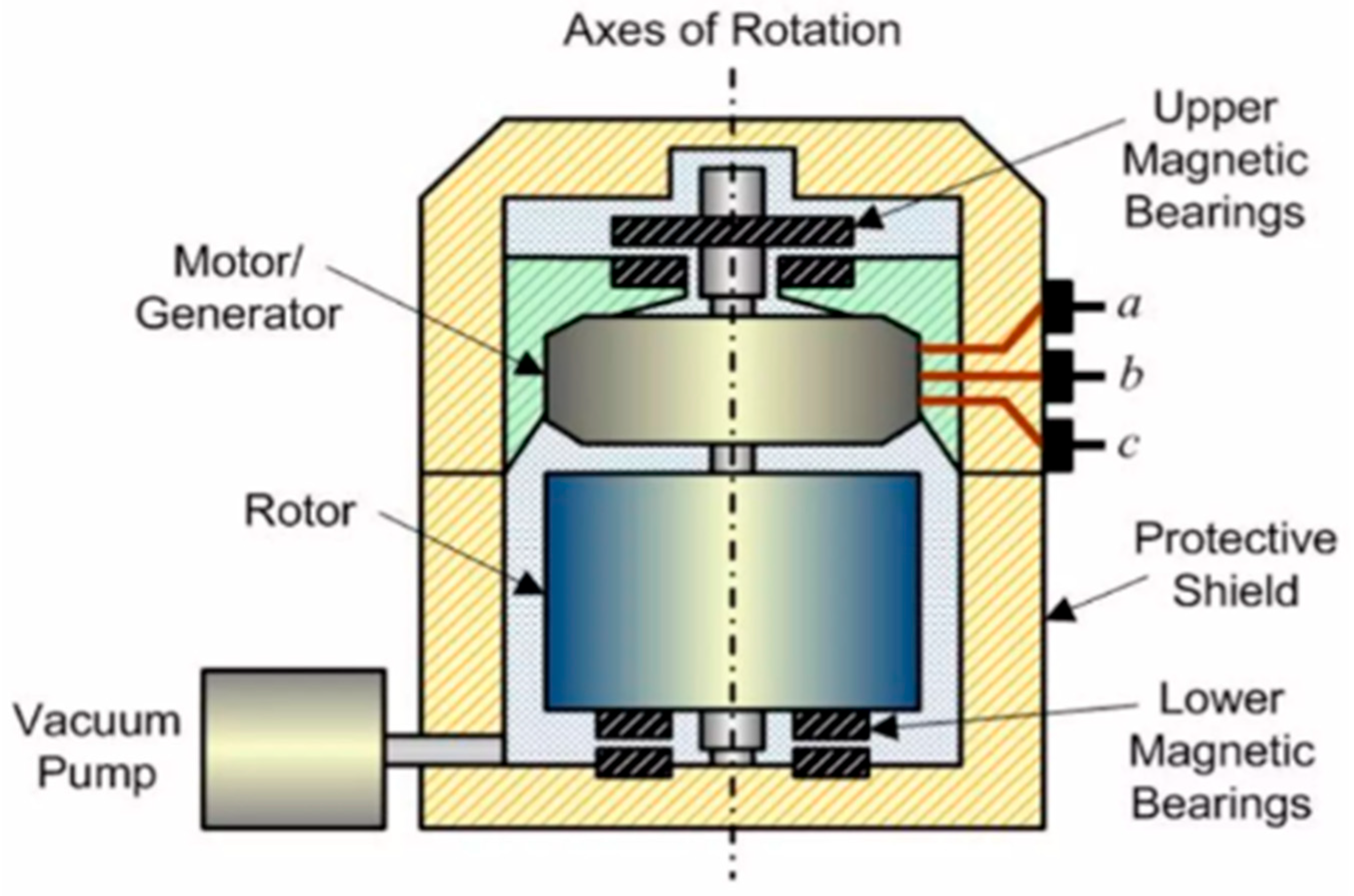

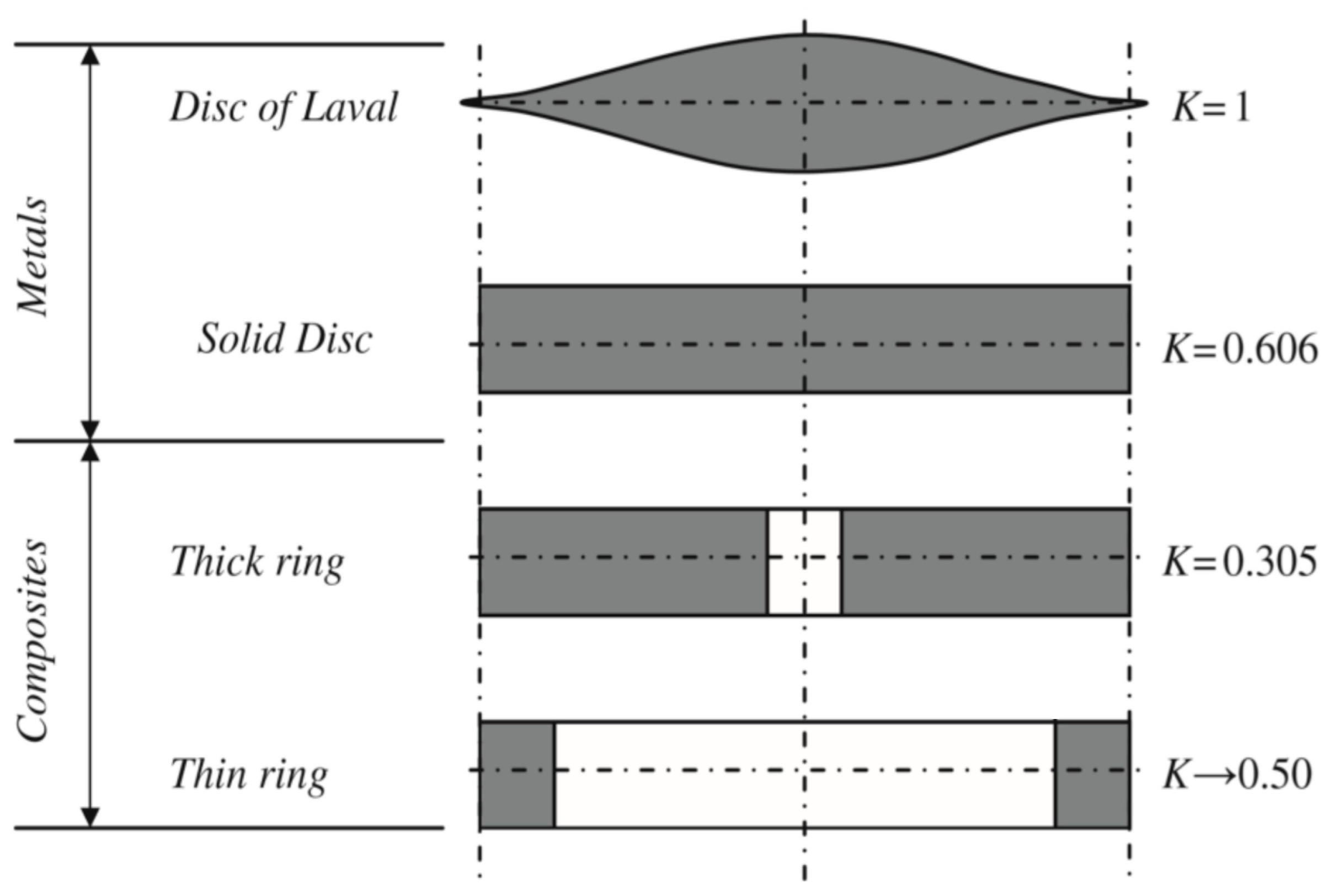
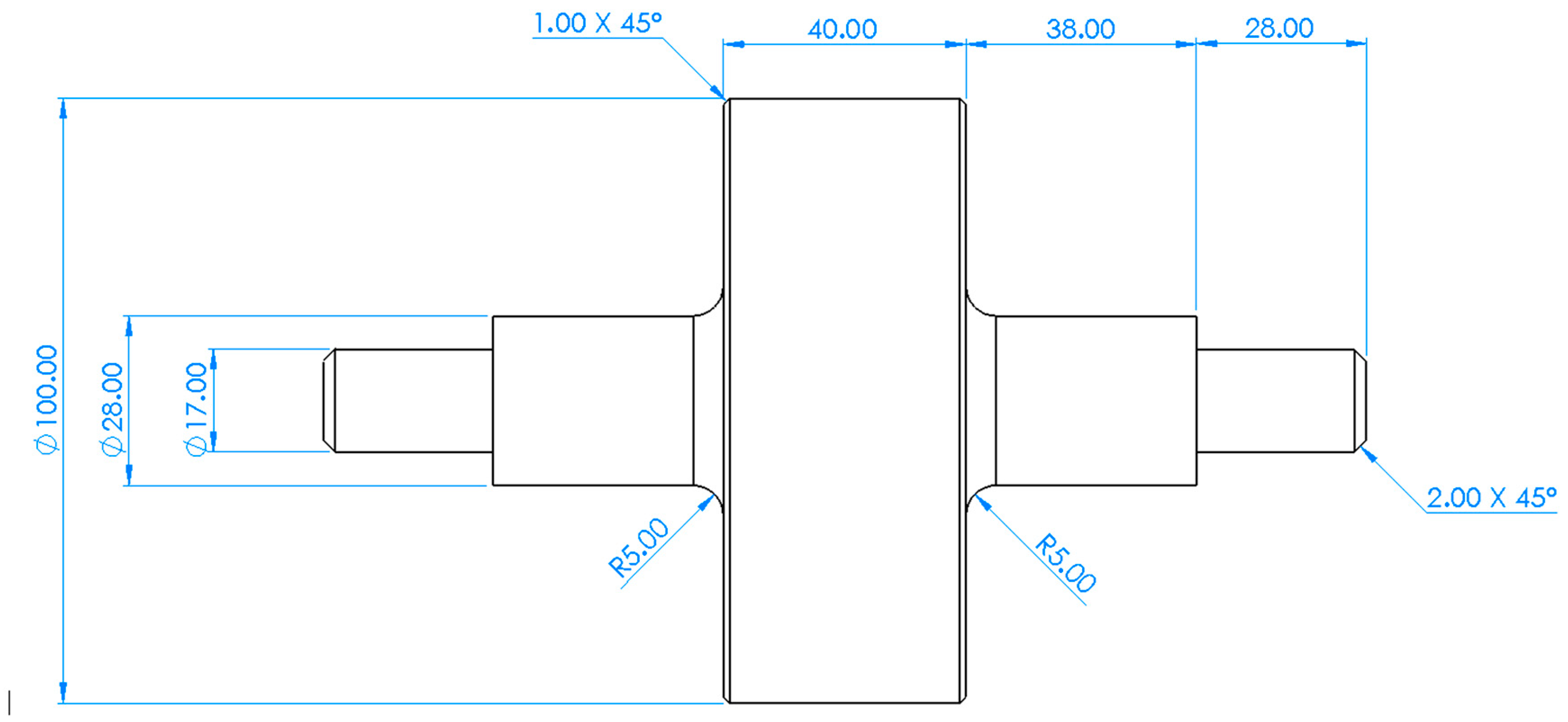
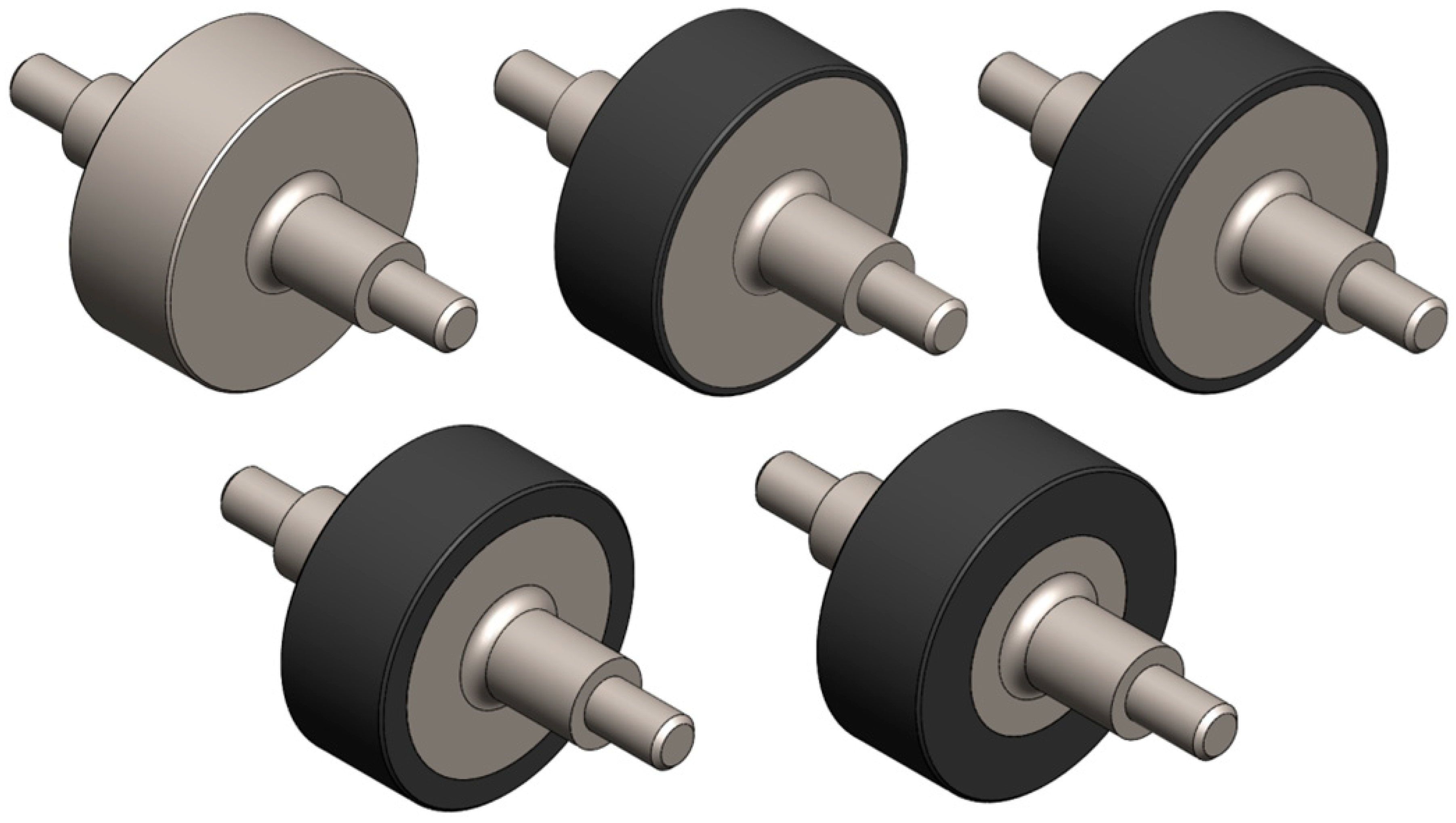

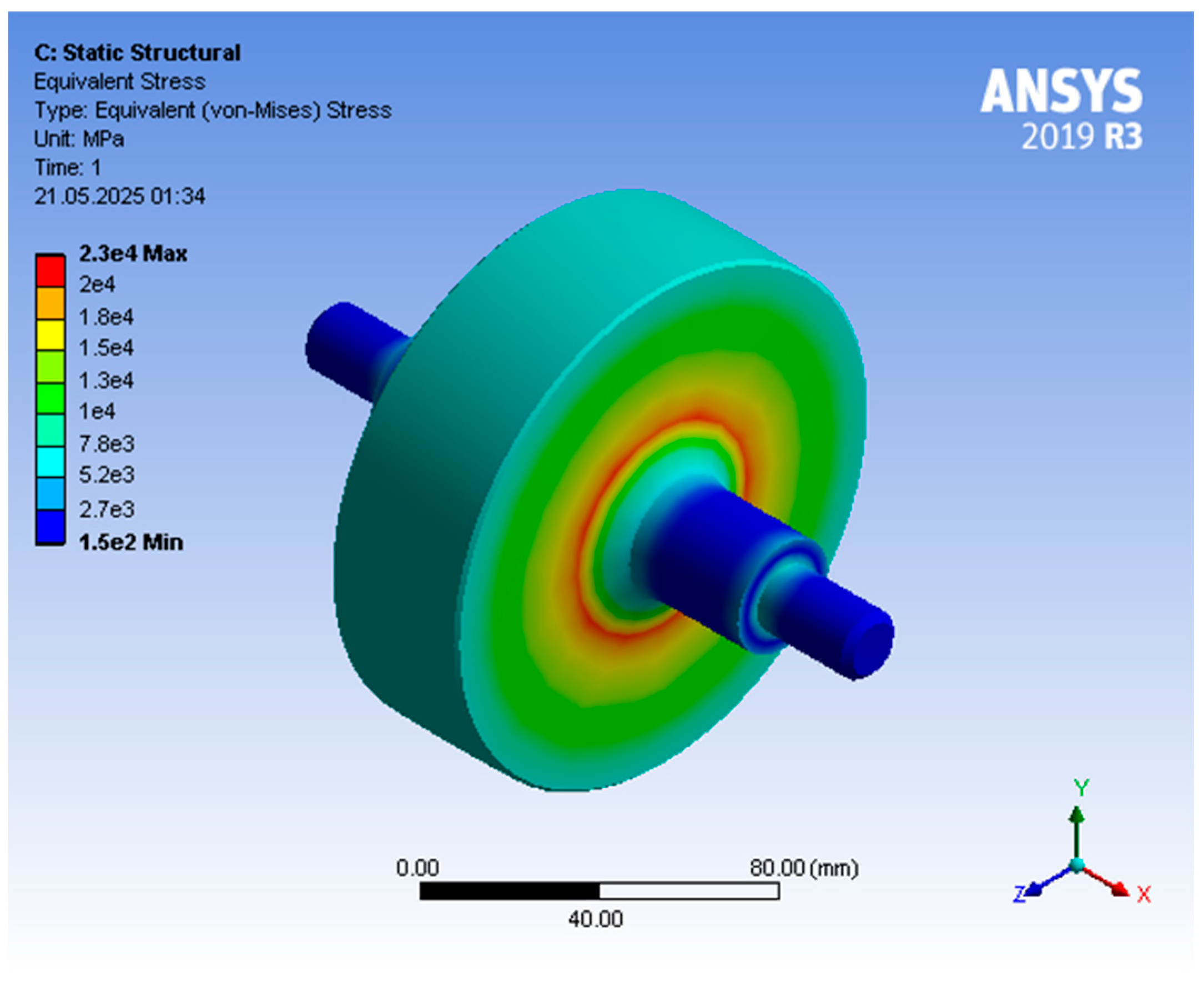

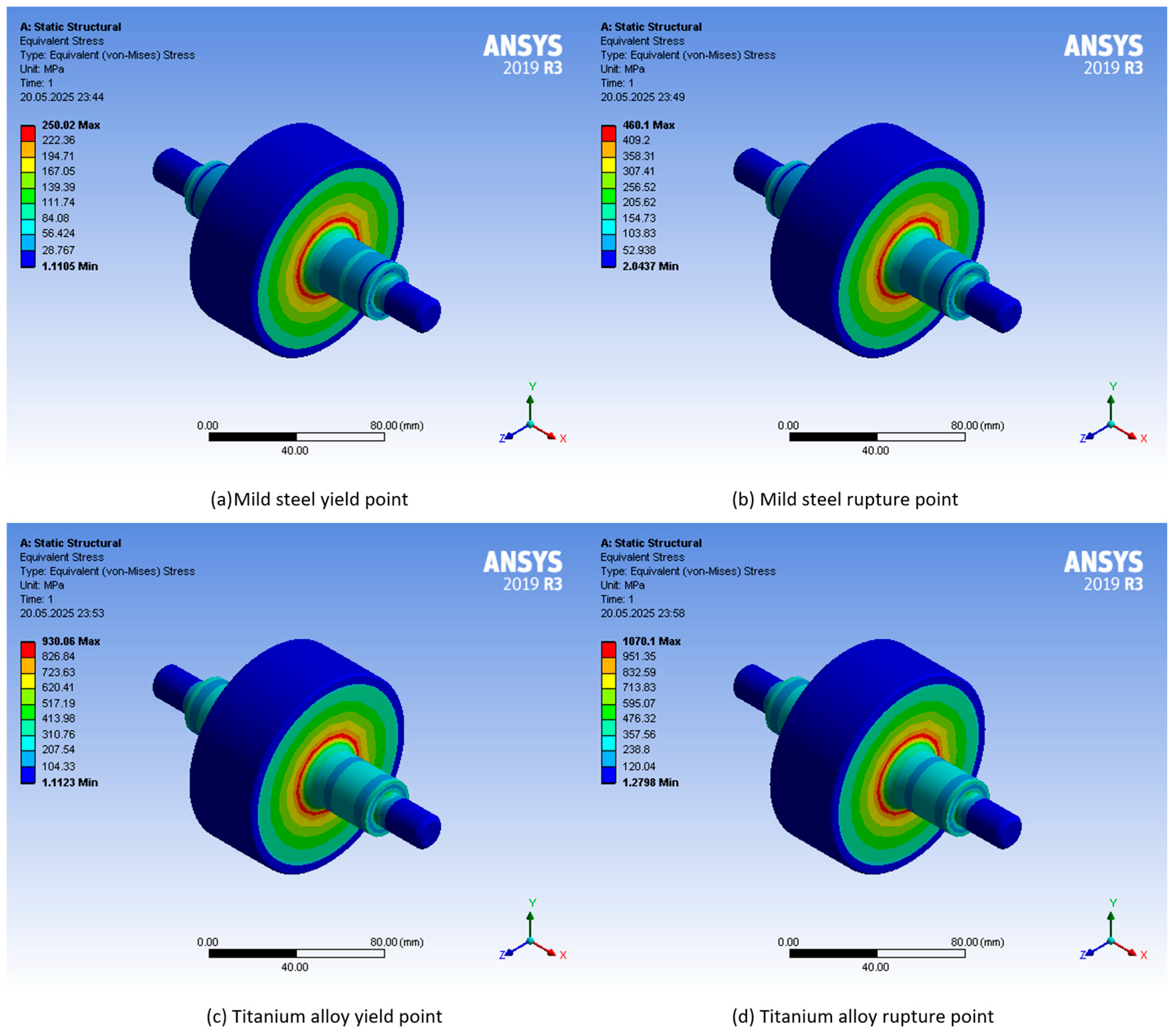

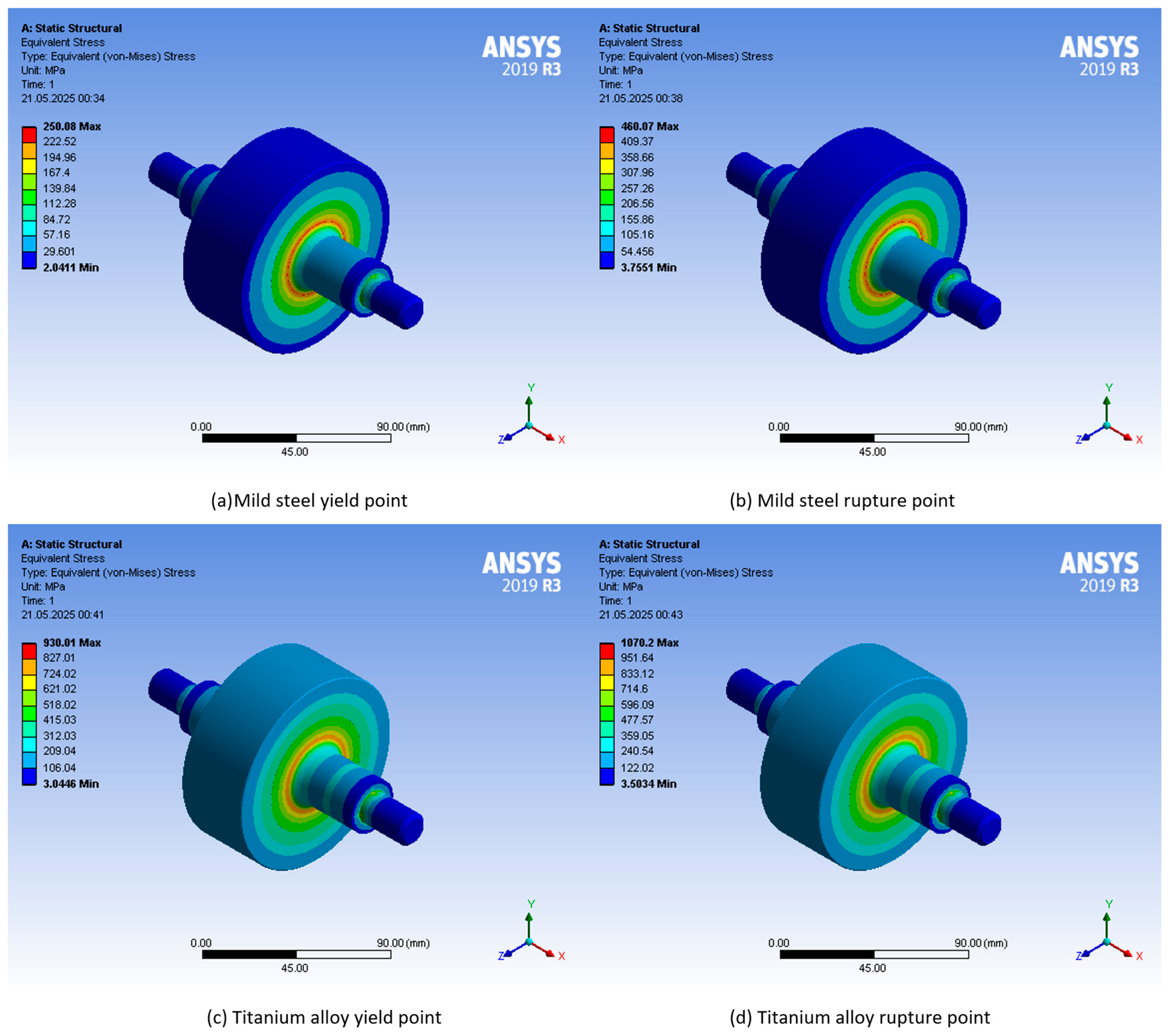
| Material | Density (kg/m3), ρ | Tensile Strength (MPa), σ | Energy Density (Wh/kg) | Cost (USD/lb) |
|---|---|---|---|---|
| Grey Cast Iron (GCI 25) | 7340 | 220 | n/a | n/a |
| Steel (AICI 4340) | 7800 | 1800 | 64 | 1 |
| Aluminum Alloy (AlMnMg) | 2800 | 600 | 61 | 3 |
| Titanium (TiAl6Zr5) | 4500 | 1200 | 75 | 9 |
| Carbon fiber (S2) | 1920 | 1470 | 213 | 24.6 |
| Carbon fiber (M30S) | 1553 | 2760 | 493 | n/a |
| Carbon fiber composite (T1000G) | 1664 | 3620 | 604 | 101.8 |
| Density | 7850 kg/m3 |
| Young’s Modulus | 2 × 108 Pa |
| Poisson’s ratio | 0.3000 |
| Bulk modulus | 1.6667 × 1011 Pa |
| Slip modulus | 7.6923 × 1011 Pa |
| Thermal coefficient of expansion | 1.2 × 10−5 1/°C |
| Yield stress | 2.5 × 108 Pa |
| Ultimate tensile strength | 4.6 × 108 Pa |
| Tensile stress | 2.05 × 108 Pa |
| Thermal conductivity | 60.500 W/m·°C |
| Specific heat | 434.00 J/kg·°C |
| Specific strength | 26 kPa/(kg/m3) |
| Density | 4620 kg/m3 |
| Young’s Modulus | 9.6 × 1010 Pa |
| Poisson’s ratio | 0.36000 |
| Bulk modulus | 1.1429 × 1011 Pa |
| Slip modulus | 3.5294 × 1010 Pa |
| Thermal coefficient of expansion | 9.4 × 10−6 1/°C |
| Yield stress | 9.3 × 108 Pa |
| Ultimate tensile strength | 1.07 × 109 Pa |
| Tensile stress | 9.0 × 108 Pa |
| Thermal conductivity | 21.900 W/m·°C |
| Specific heat | 522.00 J/kg·°C |
| Specific strength | 200 kPa/(kg/m3) |
| Density | 1800 kg/m3 |
| Young’s Modulus X-axis | 2.3 × 1011 Pa |
| Young’s Modulus Y-axis | 2.3 × 1010 Pa |
| Young’s Modulus Z-axis | 2.3 × 1010 Pa |
| Poisson’s ratio XY | 0.20000 |
| Poisson’s ratio YZ | 0.40000 |
| Poisson’s ratio XZ | 0.20000 |
| Slip modulus XY | 9 × 109 Pa |
| Slip modulus YZ | 8.2143 × 109 Pa |
| Slip modulus XZ | 9 × 109 Pa |
| Specific strength | 12.8 MPa/(kg/m3) |
| Amb. Temp.: 22 °C Ø 100 mm Rotor | Mild Steel | Mild Steel | Titanium Alloy | Titanium Alloy | Carbon Fiber-Reinforced Polymer |
|---|---|---|---|---|---|
| Yield Point | Rupture Point | Yield Point | Rupture Point | Rupture Point | |
| Speed (RPM) | 50,700 | 68,740 | 125,700 | 137,000 | 952,520 |
| Weight (kg) | 2.9 | 2.9 | 1.7 | 1.7 | 0.67 |
| Minimum (MPa) | 0.75 | 1.38 | 0.87 | 1.03 | 145.7 |
| Maximum (MPa) | 250 | 460 | 901 | 1071 | 23,000 |
| Amb. Temp.: 22 °C Ø 100 mm Rotor with 3 mm CFRP Layer | Mild Steel + 3 mm CFRP | Mild Steel + 3 mm CFRP | Titanium Alloy + 3 mm CFRP | Titanium Alloy + 3 mm CFRP |
|---|---|---|---|---|
| Yield Point | Rupture Point | Yield Point | Rupture Point | |
| Speed (RPM) | 55,350 | 75,080 | 137,850 | 147,900 |
| Weight (kg) | 2.64 + 0.065 | 2.64 + 0.065 | 1.55 + 0.065 | 1.55 + 0.065 |
| Minimum (MPa) | 0.99 | 1.82 | 0.95 | 1.1 |
| Maximum (MPa) | 250 | 460 | 930 | 1071 |
| Amb. Temp.: 22 °C Ø 100 mm Rotor with 5 mm CFRP Layer | Mild Steel + 5 mm CFRP | Mild Steel + 5 mm CFRP | Titanium Alloy + 5 mm CFRP | Titanium Alloy + 5 mm CFRP |
|---|---|---|---|---|
| Yield Point | Rupture Point | Yield Point | Rupture Point | |
| Speed (RPM) | 57,150 | 77,520 | 141,260 | 151,500 |
| Weight (kg) | 2.46 + 0.11 | 2.46 + 0.11 | 1.45 + 0.11 | 1.45 + 0.11 |
| Minimum (MPa) | 1.1 | 2.1 | 1.1 | 1.3 |
| Maximum (MPa) | 250 | 460 | 930 | 1070 |
| Amb. Temp.: 22 °C Ø 100 mm Rotor with 10 mm CFRP Layer | Mild Steel + 10 mm CFRP | Mild Steel + 10 mm CFRP | Titanium Alloy + 10 mm CFRP | Titanium Alloy + 10 mm CFRP |
|---|---|---|---|---|
| Yield Point | Rupture Point | Yield Point | Rupture Point | |
| Speed (RPM) | 60,600 | 82,140 | 144,850 | 155,350 |
| Weight (kg) | 2.04 + 0.2 | 2.04 + 0.2 | 1.2 + 0.2 | 1.2 + 0.2 |
| Minimum (MPa) | 0.96 | 1.77 | 1.37 | 1.58 |
| Maximum (MPa) | 250 | 460 | 930 | 1070 |
| Amb. Temp.: 22 °C Ø 100 mm Rotor with 20 mm CFRP Layer | Mild Steel + 20 mm CFRP | Mild Steel + 20 mm CFRP | Titanium Alloy + 20 mm CFRP | Titanium Alloy + 20 mm CFRP |
|---|---|---|---|---|
| Yield Point | Rupture Point | Yield Point | Rupture Point | |
| Speed (RPM) | 73,500 | 96,650 | 163,860 | 175,800 |
| Weight (kg) | 1.33 + 0.36 | 1.33 + 0.36 | 0.8 + 0.36 | 0.8 + 0.36 |
| Minimum (MPa) | 2.1 | 3.8 | 3 | 1.5 |
| Maximum (MPa) | 250 | 460 | 930 | 1071 |
| Amb. Temp.: 22 °C Ø 100 mm Rotor | Mild Steel | Titanium Alloy | Carbon Fiber-Reinforced Polymer |
|---|---|---|---|
| Yield Point | Yield Point | Rupture Point | |
| Speed (RPM) (Analytical) | 53,047 | 132,220 | 1,047,211 |
| Speed (RPM) (ANSYS) | 50,700 | 125,700 | 952,520 |
| Weight (kg) | 2.9 | 1.7 | 0.67 |
| Maximum (MPa) | 250 | 901 | 23,000 |
| Rotor Material | Yield Stress (RPM) | Rupture Stress (RPM) | Total Rotor Weight (kg) |
|---|---|---|---|
| Mild steel | 50,700 | 68,740 | 2.9203 |
| Titanium alloy | 125,700 | 137,000 | 1.7187 |
| CFRP (230 GPA) | - | 952,500 | 0.6696 |
| Hybrid structure | |||
| Mild steel—3 mm CFRP | 55,350 | 75,080 | 2.7023 (M: 97.6% C: 2.4%) |
| Mild steel—5 mm CFRP | 57,150 | 77,520 | 2.5634 (M: 95.8% C: 4.2%) |
| Mild steel—10 mm CFRP | 60,600 | 82,140 | 2.2413 (M: 91% C: 9%) |
| Mild steel—20 mm CFRP | 73,500 | 99,650 | 1.7115 (M: 77.7% C: 22.3%) |
| Titanium alloy—3 mm CFRP | 137,580 | 147,900 | 1.6173 (T: 96% C: 4%) |
| Titanium alloy—5 mm CFRP | 141,260 | 151,500 | 1.5526 (T: 93.1% C: 6.9%) |
| Titanium alloy—10 mm CFRP | 144,850 | 155,350 | 1.4025 (T: 85.5% C: 14.5%) |
| Titanium alloy—20 mm CFRP | 163,860 | 175,800 | 1.1558 (T: 68.8% C: 31.2%) |
| Rotor Material | Yield Stress (RPM) | Yield Stress (km/h) | Rupture Stress (RPM) | Rupture Stress (km/h) |
|---|---|---|---|---|
| Mild steel | 50,700 | 955.67 | 68,740 | 1295.72 |
| Titanium alloy | 125,700 | 2369.4 | 137,000 | 2582.4 |
| CFRP (230 GPA) | - | - | 952,500 | 17,954.2 |
| Hybrid structure | ||||
| Mild steel—3 mm CFRP | 55,350 | 1043.32 | 75,080 | 1415.22 |
| Mild steel—5 mm CFRP | 57,150 | 1077.25 | 77,520 | 1461.22 |
| Mild steel—10 mm CFRP | 60,600 | 1142.28 | 82,140 | 1548.3 |
| Mild steel—20 mm CFRP | 73,500 | 1385.44 | 99,650 | 1878.36 |
| Titanium alloy—3 mm CFRP | 137,580 | 2593.32 | 147,900 | 2787.85 |
| Titanium alloy—5 mm CFRP | 141,260 | 2662.7 | 151,500 | 2855.7 |
| Titanium alloy—10 mm CFRP | 144,850 | 2730.36 | 155,350 | 2928.28 |
| Titanium alloy—20 mm CFRP | 163,860 | 3088.7 | 175,800 | 3313.75 |
| Rotor Material | Yield Stress (RPM) | Stored Energy (Wh) | Rupture Stress (RPM) | Stored Energy (Wh) |
|---|---|---|---|---|
| Mild steel | 50,700 | 14.29 | 68,740 | 26.27 |
| Titanium alloy | 125,700 | 51.7 | 137,000 | 61.42 |
| CFRP (230 GPA) | - | - | 952,500 | 1156.63 |
| Hybrid structure | ||||
| Mild steel—3 mm CFRP | 55,350 | 15.76 | 75,080 | 29 |
| Mild steel—5 mm CFRP | 57,150 | 15.94 | 77,520 | 29.3 |
| Mild steel—10 mm CFRP | 60,600 | 15.67 | 82,140 | 28.8 |
| Mild steel—20 mm CFRP | 73,500 | 17.6 | 99,650 | 32.32 |
| Titanium alloy—3 mm CFRP | 137,580 | 58.28 | 147,900 | 67.35 |
| Titanium alloy—5 mm CFRP | 141,260 | 59 | 151,500 | 67.85 |
| Titanium alloy—10 mm CFRP | 144,850 | 56 | 155,350 | 64.44 |
| Titanium alloy—20 mm CFRP | 163,860 | 59.1 | 175,800 | 68 |
| Rotor Material | Maximum RPM | Production Cost | Material Cost | Stored Energy (Wh) | Total Rotor Weight (kg) | Energy Density (Wh/kg) |
|---|---|---|---|---|---|---|
| Mild steel | 68,740 | 1 | 1 | 26.27 | 2.92 | 9 |
| Titanium alloy | 137,000 | 2 | 2 | 61.42 | 1.72 | 35.7 |
| Mild steel—20 mm CFRP | 99,650 | 3 | 3 | 32.32 | 1.71 | 18.9 |
| Titanium alloy—20 mm CFRP | 175,800 | 4 | 4 | 68 | 1.16 | 58.8 |
| CFRP (23 GPA) | 952,500 | 5 | 5 | 1156.63 | 0.67 | 1727 |
Disclaimer/Publisher’s Note: The statements, opinions and data contained in all publications are solely those of the individual author(s) and contributor(s) and not of MDPI and/or the editor(s). MDPI and/or the editor(s) disclaim responsibility for any injury to people or property resulting from any ideas, methods, instructions or products referred to in the content. |
© 2025 by the authors. Licensee MDPI, Basel, Switzerland. This article is an open access article distributed under the terms and conditions of the Creative Commons Attribution (CC BY) license (https://creativecommons.org/licenses/by/4.0/).
Share and Cite
Yangoz, C.; Erhan, K. High-Speed Kinetic Energy Storage System Development and ANSYS Analysis of Hybrid Multi-Layered Rotor Structure. Appl. Sci. 2025, 15, 5759. https://doi.org/10.3390/app15105759
Yangoz C, Erhan K. High-Speed Kinetic Energy Storage System Development and ANSYS Analysis of Hybrid Multi-Layered Rotor Structure. Applied Sciences. 2025; 15(10):5759. https://doi.org/10.3390/app15105759
Chicago/Turabian StyleYangoz, Cenk, and Koray Erhan. 2025. "High-Speed Kinetic Energy Storage System Development and ANSYS Analysis of Hybrid Multi-Layered Rotor Structure" Applied Sciences 15, no. 10: 5759. https://doi.org/10.3390/app15105759
APA StyleYangoz, C., & Erhan, K. (2025). High-Speed Kinetic Energy Storage System Development and ANSYS Analysis of Hybrid Multi-Layered Rotor Structure. Applied Sciences, 15(10), 5759. https://doi.org/10.3390/app15105759







